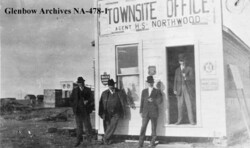
History
Coronation was named in honour of the coronation of King George V. The Town was registered as a Village on December 16, 1911, and by April 29, 1912, was declared a Town. Some of the original buildings from Coronation’s early years remain, but fires over the years have taken their toll on some of the historical sites.
“September 27, will go down in the history of Coronation as alpha of her existence. From this date will be reckoned the building, not only of business establishments, but of character and it may be of fortunes also.” The above was the first paragraph of the September 27, 1911 edition of The News Review, published the day Coronation came into existence. An ‘instant town’ sprang up immediately following the sale of twenty-four blocks of land. Many buildings from Haneyville, six miles away, were moved into town as soon as the lots were sold.
The development of Coronation was based on agriculture and the rich natural resources of the area. The discovery of oil and natural gas in the 1950’s helped to boost the economy of the region, and gave the community a second industry.
Coronation has had its share of champions. The Coronation Cadet Corps brought home many trophies for excellence, especially marksmanship. There has been more than one brome grass champion, as well as various cattle breeders showing championship stock, helping to put Coronation on the map.
Courtesy of Coronation Review
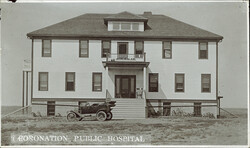
The Coronation General Hospital was opened in January, 1915, and was built by the town of Coronation through the sale of debentures, at a cost of $12,000. The Hospital was a two-storey 32’ x 60’ frame building with a full sized cement basement. It housed two public wards, one semi-private ward and seven private wards, giving a total accommodation of 16 beds. Other facilities included a fully equipped and up-to-date operating room; sterilizing room, Doctor’s dressing room, dispensary, dining room, and 2 bathrooms. The basement housed the kitchen, pantry and store room, furnace rooms, laundry rooms and rooms for the help.
The staff consisted of a matron, two nurses, a housekeeper and an orderly. There were two attending physicians: Dr. J.S. Brookman and Dr. E. Little. The physicians handled medical, surgical and maternity cases. The Hospital was managed by a board appointed by Town Council, and was funded from patient fees, which in 1915 were $2 per day for a public ward bed, $2.50 per day for a semi-private bed, and $3 per day for a private bed. The hospital also received a government grant of $0.25 per patient, per day.
In 1958, town ratepayers met to discuss the replacement of the hospital, due to the potential condemnation of the building. On October 19, 1960 the new hospital was opened and plans were announced for the addition of a 25-bed auxiliary hospital.
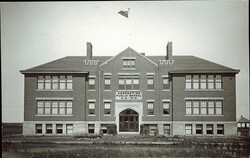
On December 1, 1911 school began in Coronation on the second floor of a downtown building that later became Anderson’s Funeral Home. C.F. Stein was the first teacher. To accommodate all the school-aged children until the big brick school was completed, three or four different buildings in the town were used as classrooms. The construction of the Coronation School was completed in 1913 at a cost of $40,000. Frank Stockwell operated the dray line that hauled all the lumber and bricks to build the school.
In 1946 the school received a new heating plant, and a three-room addition was built in 1947-48 to
accommodate the students that would be bussed in from the surrounding area, as a result of the closure of a number of one-room schools.
In 1964 the original school house was torn down and the new school gymnasium addition was built where it stood.
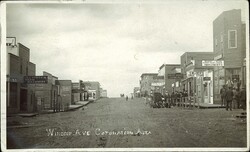
Although the N.W.M.P had been in existence for many years, each town had their own constable to maintain local law and order. Following the saga of Coronation’s early town constables through the years, is quite an entertaining story.
The first constable was always in hot water. It seems in every Town Council meeting he had done something wrong. He either had been too strict or too lax for some problem or another.
Things finally came to a head when he was sent to investigate the local house of ill repute. It seems he was a bit too vigorous in his investigation and stayed the night. The town mothers, who had lodged the complaint, were none too happy to say the least. However, he humbly apologized and kept his job.
A year or so later, off he went again to the same house of ill repute, and for some reason, not explained, he discharged his weapon. He was fired for this, and another man was hired.
The new constable was not an improvement. Some six months later, he was brought up on charges of running a protection ring. Not only did he charge business owners for protecting them, if they didn’t pay, he is alleged to have done whatever harm he could. It is never explained what happened to him, except he was fired and the previous constable was rehired.
It must have not been a very desirable job, because the first constable was hired and fired several times over the course of the next 10 years.
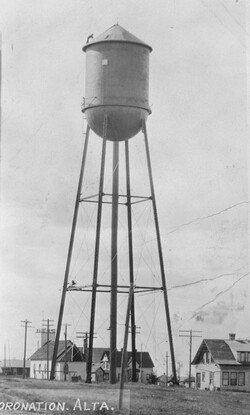
Aug. 1912
- The Engineer requests $20,000.00 to proceed with waterworks and powerhouse. The Town only had $8000.00
Feb. 1913
- Town arranges $38,000.00 debenture for waterworks, and $12,000.00 for power plant.
Mar. 1914
- Tenders called for:
- Canadian Westinghouse – generator $1835.00,
- Ontario Wind Power – deep well pump $610.94,
- Des Moines Bridge & Steel – water tower (They were in business until 2000, unfortunately no records are available for them.)
July 1914
- Expenses to date: Water tower – $12,299.89, power plant $2,722.62. The bricks for the power plant cost $7.50 per 1000.
Aug 1914
- Expenses to date: Water tower $20,882.91, power plant $4,169.35
Sept 1914
- Completed expenses: $32,212.32
Sept 1914
- Water rates set:
- livery barns $10.00/mo,
- restaurants $1.00/wk,
- laundries $1.00/wk,
- dwellings $1.00/wk,
- bathtubs $0.50 extra/mo.
Oct. 1914
- Electric meters installed
Dec. 1914
- Electric rates set: $0.20/kwh, $0.12 for over 40kwh. Customers complained about the cost.
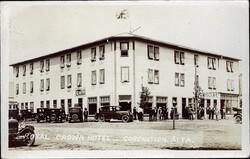
The Royal Crown Hotel was built in 1911. The Hotel was a three story structure, and boasted 60 guest rooms. It was the center of social activity in the community. The dining room was especially busy on weekends, when everyone came to town. In 1913 the Hotel installed their own electric plant and in 1924, the Hotel applied for a beer license.
The various hotel proprietors included Wilson & Fraser (1911-1927); Frank K. Miller (1927-1934); Florence Miller (1934-1943); W.A. Kelly (1943-1944); George Radowits (1944-1951); Joe Karpa (1951-1975); Prairie Lane Motor Inn Ltd. (1975-1981); Industrial Door Service Ltd. (1981); 243129 Alberta Ltd. (1981-1989); Town of Coronation (1989-1995); McKenzie Motors (1995-Present)
On the night of January 13, 1982 the Hotel was destroyed by a fire of undetermined origin.
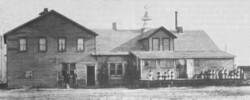
In 1917 the Kofoed Brothers completed a modern Creamery with a refrigeration plant, pasteurizer and a butter making capacity of 1000 lbs. per day. This Creamery was to provide the only source of farm income for many families during the 30’s when the sale of a weekly can of cream or a few dozen eggs was all that kept a little food on the table.
It was operated privately by various owners until Swifts took over in 1924. In 1945, it was sold to Central Alberta Dairy Pool and a pasteurization plant was installed in 1947. In 1954, CADP Creamery won first prize, including a silver cup, for the best butter out of 128 entries. In 1969 Dave and Elsie Hall purchased the Creamery. It then became a convenience store and milk distribution center. A bakery was also added. In 1991 the store was purchased by Kim and Judy Redelback, and took up residence in the spacious five bedroom apartment over the store, which was then named the Korner Kash & Karry. Kim and Judy sold the store in 2003 and it is still operating under the same name
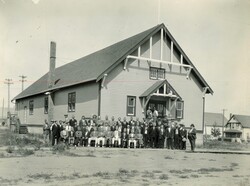
In July 1927, construction of the Elks’ Hall was undertaken by the Coronation Benevolent and Protective Order of Elks (BPOE). The Club maintained an active membership from 1926 until 1941, when they disbanded. In 1945 the Hall was leased to the Canadian Legion for a ten year term. In March of 1950, the Legion excavated under the building and a Bowling Alley was installed in the Hall basement. The Bowling Alley was operated by Archie Waltham, and it provided a new source of recreation for the Town’s residents. The Legion gave up their lease on the building in 1955.
In 1952 the Elks Lodge formed for the second time and have maintained an active membership to the present day. The Elks’ Hall was utilized by residents for weddings, funerals, anniversary and birthday celebrations, meetings and a variety of other community events.
In 2006 the Town of Coronation was forced to demolish the 80-year old building due to structural issues.
